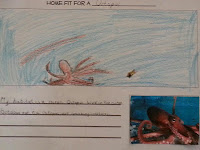I created a SmartBoard activity where the students reviewed by dragging the different animals, terrains, and plants to the habitats where they belonged.
Before the activity I had found 24 pictures of animals to represent the habitats, 6 from each habitat. As the students selected the animal that they drug to the habitat I handed them a picture of that animal to keep at their desk.
I told the kids that I was buying a zoo except I didn't really know how to take care of the animals and which type of habitats I should build for them so I needed their help! The picture of the animal I gave them was going to be the animal they were in charge of at my zoo. I handed out a worksheet I created and they had to glue the picture I gave them to the bottom right corner, draw a picture of what the animal's habitat would look like at the top, and write a description telling me about the habitat and the animal. When they were done with their habitat paper I gave them a necklace with a Junior Zookeeper badge attached to it where I wrote their name and the animal they were in charge of.


















